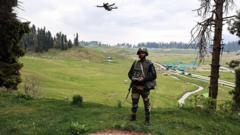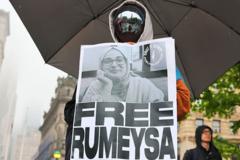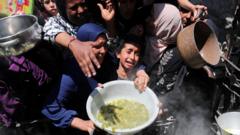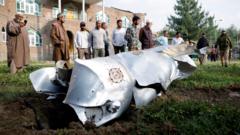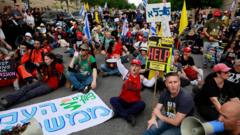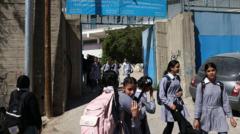The recent airstrike on a bustling restaurant in Gaza City resulted in 33 deaths and numerous injuries. Eyewitness accounts portray a scene of chaos and despair, as locals grapple with the return of conflict following a collapsed cease-fire.
Gaza's Night of Terror: Airstrike Claims Lives and Hearts

Gaza's Night of Terror: Airstrike Claims Lives and Hearts
A devastating airstrike in Gaza City leaves a vibrant restaurant scene shattered, underscoring the human toll of conflict amid dwindling hopes for peace.
In a tragic incident on Wednesday, a late afternoon airstrike targeted a popular restaurant in the Rimal neighborhood of Gaza City, transforming it from a lively hub of young patrons enjoying pizza and crepes into a scene of horror and destruction. Amid fellowship and laughter, the chaos erupted, catching diners off guard as the Israeli military’s strike took the lives of 33 individuals and injured 155 others, as reported by the local health ministry.
Witnesses, who were nearby, described the sequence of events—one moment filled with camaraderie, swiftly changing to cries of pain and instinctual propensiveness as the dust settled. Many attempted to assist those injured, utilizing whatever resources available in the aftermath of the attack, including prayer rugs transformed into makeshift bandages.
Local health officials reported that the death toll throughout Gaza that day reached a staggering 59, although figures did not specify between combatants and civilians. As the dust settled, some families searched for answers among the devastation. The Israeli military, in a statement, claimed their operations were targeted, stating they had struck two key Hamas figures in the neighborhood and had taken precautions to minimize civilian harm.
This strike follows the collapse of a ceasefire earlier in March, which had halted hostilities temporarily. The Israeli military, following the October attack on Israel, asserts that their operations will intensify until the remaining hostages are released. This recent round of violence has left many Gazans disillusioned, as voiced by a witness who lamented, "Enough, enough of the bloodshed happening."
The remnants of peace linger in the neighborhood, exemplified by decorative lights that once illuminated joyous gatherings during the cease-fire, now overshadowed by the grim reality of ongoing conflict. The loss and anguish in Gaza City serve as a poignant reminder of the human cost of war, emphasizing the urgent need for dialogue and a sustainable resolution to end the suffering.
Witnesses, who were nearby, described the sequence of events—one moment filled with camaraderie, swiftly changing to cries of pain and instinctual propensiveness as the dust settled. Many attempted to assist those injured, utilizing whatever resources available in the aftermath of the attack, including prayer rugs transformed into makeshift bandages.
Local health officials reported that the death toll throughout Gaza that day reached a staggering 59, although figures did not specify between combatants and civilians. As the dust settled, some families searched for answers among the devastation. The Israeli military, in a statement, claimed their operations were targeted, stating they had struck two key Hamas figures in the neighborhood and had taken precautions to minimize civilian harm.
This strike follows the collapse of a ceasefire earlier in March, which had halted hostilities temporarily. The Israeli military, following the October attack on Israel, asserts that their operations will intensify until the remaining hostages are released. This recent round of violence has left many Gazans disillusioned, as voiced by a witness who lamented, "Enough, enough of the bloodshed happening."
The remnants of peace linger in the neighborhood, exemplified by decorative lights that once illuminated joyous gatherings during the cease-fire, now overshadowed by the grim reality of ongoing conflict. The loss and anguish in Gaza City serve as a poignant reminder of the human cost of war, emphasizing the urgent need for dialogue and a sustainable resolution to end the suffering.


